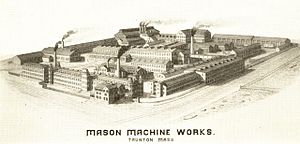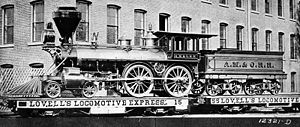- Mason Machine Works
-
The Mason Machine Works was a machinery manufacturing company located in Taunton, Massachusetts between 1845 and 1944. The company became famous for an early invention by its creator, William Mason, the self-acting mule, first patented in 1840. The company also later produced locomotives, rifles during the American Civil War, and later printing presses. However, the production of textile machinery would remain the company's core business during the late 19th century, until its decline in the 1920s.
Contents
Origins
The son of a blacksmith born in 1808 at Mystic, Connecticut, William Mason became a skilled master mechanic while still in his teens, working for various companies in the Killingly, Connecticut area that were involved with machinery for the growing textile industry.[1]
In 1835, Mason moved to Taunton, Massachusetts to work for Crocker and Richmond, a company that made ring spinning frames for the cotton textile industry. While the firm failed in financial crisis of 1837, it was soon taken over by Leach and Keith. Mason was made foreman.[2]
Textile Machinery
By the time William Mason began his career, there had been a growing industry of machine building in the growing United States. It was a specialized art requiring tools, materials, skills and designs that had been gradually increasing through the early part of the 19th century. The ideas of early pioneers in the textile machine industry such as David Wilkinson at Pawtucket, Rhode Island and Paul Moody at Waltham, Massachusetts were constantly being tinkered with an improved upon during this time.
On October 8, 1840, Mason's greatest invention, the "self-acting mule" was patented. Competition required improvements and on October 3, 1846, he received a patent for "Mason's Self-acting Mule." The self-acting mule was a triumph of automation.[3]
This device would become the industry standard for years to come.
With the failure of Leach and Keith in 1842, William Mason convinced investors to help him establish his own company, the Mason Machine Works. In 1845, new buildings were erected and the plant became the largest one devoted to the manufacture of machinery in the country. It made cotton machinery, woolen machinery, machinists' tools, blowers, cupola furnaces, gearing, shafting, and railroad car wheels made with spokes.
The Mason Machine Works would become most important company in Taunton, Massachusetts for much of the 19th century.
Locomotives
After 1852, the company expanded again, venturing into the locomotive business. Mason's innovative locomotive designs quickly drew praise from railroad engineers and operators, and were known to be the easiest engines to repair. His ideas and improvements would later be adopted by other locomotive builders.
The company would construct 754 steam locomotives between 1853 and 1889. However, after William Mason's death in 1883, the firm would mostly concentrate on its core business of textile machinery.[4]
Two locomotives built by Mason have been preserved, both fully operational. One is the Baltimore and Ohio Railroad's number 25, a 4-4-0 type engine built in 1856, which was later named in honor of Mason. It is currently at the Baltimore and Ohio Railroad Museum. The other is Hecla & Torch Lake Railroad Number 3, a 0-6-4 engine of the Mason Bogie design built in 1873, currently at the Henry Ford Museum.
Civil War Rifles and Printing Presses
In 1861, with the start of the Civil War, Mason accepted a contract from the United States Government for the production of 100,000 Springfield model rifles. The company embarked on a large expansion to handle the new contract. However, the War Department eventually decided to cut the contract to only 30,000 rifles.
After the war, the company again focused on producing high-quality textile machinery and locomotives. The factory expanded to more than 10 acres (40,000 m2) near the western end of downtown Taunton.
In 1879, Mason's reputation for quality workmanship let to a contract to manufacture of the Campbell printing press, originally patented and built in Brooklyn, New York.[5]
Decline and Legacy
With the demise of the northern textile industry during the 1920s, Mason was reduced to producing mostly spare parts for the machines which it had sold previously to an ever-decreasing number of textile manufacturers. By the 1930s, portions of the site were occupied by Grossman's Lumber Company and the Southern New England Terminals trucking company.[6]
The Mason Machine Works finally went out of business in 1944.[7]
Grossman's continued to occupy much of the former Mason property until late 1960s, when the property became earmarked for demolition by the City of Taunton, as part of an urban renewal project. The site was vacated by October 1969.[8]
However, with demolition slated to begin, the complex was destroyed by fire on December 30, 1970.[9]
Today the site is occupied by a bus depot and garage, an apartment building and other businesses. A portion of the site remains open and has not been redeveloped, due to likely soil contamination issues associated with the Machine Works operations.[10]
See also
- Mason Bogie
- Draper Corporation
- Paul Moody
- Spinning mule
- Taunton Locomotive Manufacturing Company
- Whitin Machine Works
References
- ^ William Mason The National Cyclopaedia of American Biography
- ^ William Mason papers
- ^ The Run of the Mill, Steve Dunwell, 1978
- ^ List of all Mason Locomotives
- ^ History of Bristol County
- ^ Sanborn Map, Taunton, Mass. 1937
- ^ Taunton and Mason, John W. Lozier, 1986
- ^ Arthur Wallace, Mason Steam Locomotives, 2004
- ^ Taunton Daily Gazette, December 31, 1970
- ^ A History of Taunton, Massachusetts, William F. Hanna, 2007
External links
North American locomotive builders ALCO • Alco-GE • Altoona Works • Atlas • Baldwin • Bombardier • Brooks • Brookville • CLC • Climax • Cooke • Davenport • Dickson • EMD • Fairbanks-Morse • GE Transportation • GMD • Globe • Grant • Harlan and Hollingsworth • Hinkley • Ingalls • Jewett • Lima • Manchester • Mason • MLW • Mount Clare Shops • Mount Savage • NREC • Norris • Pittsburgh • Porter • Portland • Progress Rail Services • Railpower • Rhode Island • Richmond • Rogers • Schenectady • SLCC • Taunton • Tredegar • Vulcan • Wabtec • Westinghouse • Whitcomb • WillametteSee also: List of locomotive builders Categories:- Locomotive manufacturers of the United States
- History of the textile industry
- Textile machinery manufacturers
- Defunct manufacturing companies of the United States
- Buildings and structures in Taunton, Massachusetts
- Industrial archaeology
- Companies based in Massachusetts
Wikimedia Foundation. 2010.




